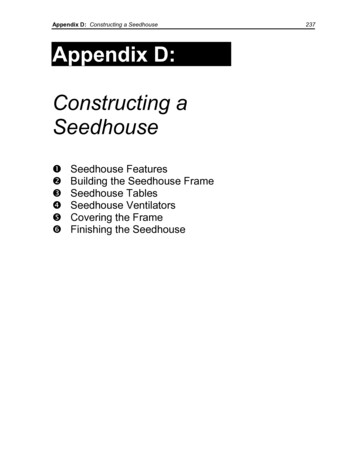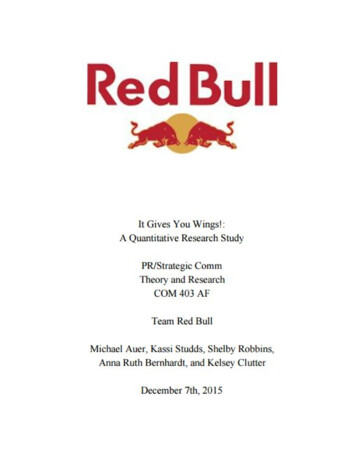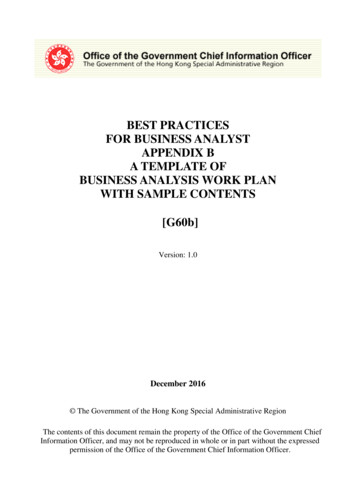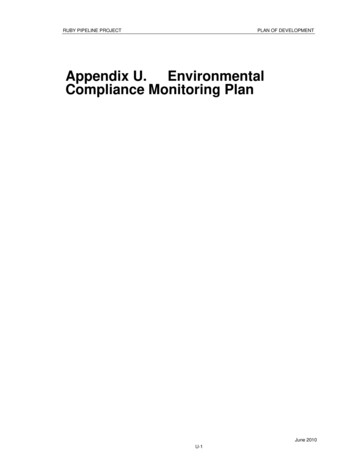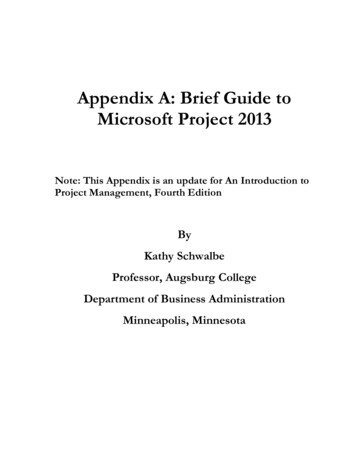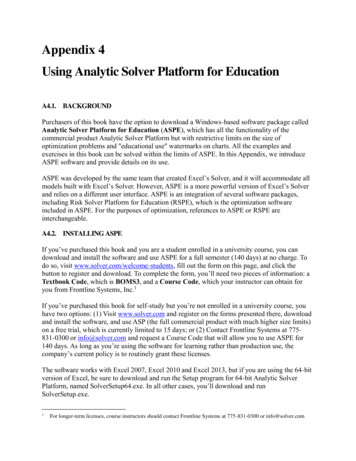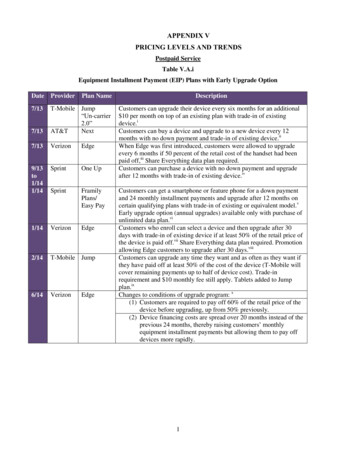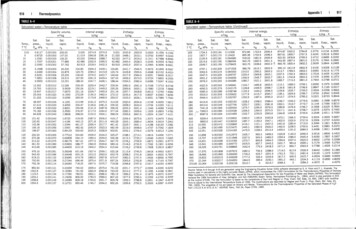
Transcription
Appendix D: NORS Guidance for Contributing Factors (CF)in Foodborne Outbreak ReportsContributing FactorsIntroductionContributing factors (CFs) are defined as the practices and behaviors which most likely contributed to a foodborne illness outbreak. ACF should be identified only if the investigator has strong evidence that it actually occurred in this outbreak; just because a factor hasbeen cited in similar outbreaks in the past does not mean it was involved in this outbreak.Please select any and all CFs that are causally associated with the outbreak.After consideration of all epidemiological, laboratory, and environmental assessment information available, if contributing factors forthis outbreak could not be determined, then at the top of the contributing factors section, the box ‘Contributing Factors Unknown’should be checked. If this box is checked, then the remainder of the contributing factors section should be left completely blank.ClassificationCFs are classified into 3 categories (contamination, proliferation/amplification, and survival factors):Contamination Factors Factors that introduce or otherwise permit contamination. Contamination factors relate to how the etiologic agent got onto or into the food vehicle. There are 15 contamination factors, numbered C1 – C15. C-N/A is utilized if contamination factors were not related to the type of etiologic agent involved in the outbreak. C-N/A shouldrarely, if ever, be cited.If no contamination factors were identified, then leave all contamination factors blank.Proliferation/Amplification Factors Factors that allow proliferation or growth of etiologic agents. Citation of proliferation/amplification factors is only applicable when bacterial agents are involved. Proliferation factors relate to how bacterial agents were able to increase in numbers and/or produce toxic products prior to thevehicle being ingested. There are 12 proliferation/amplification factors, numbered P1 – P12. P-N/A is utilized if proliferation/amplification factors are not related to the type of etiologic agent involved in the outbreak. Forexample, proliferation/amplification factors would not be cited in a viral outbreak.If no proliferation/amplification factors were identified, then leave all proliferation/amplification factors blank.Survival Factors Factors that allow survival or fail to inactivate the contaminant. Citation of survival factors is only applicable when microbial agents are involved. Survival factors refer to processes or steps that should have eliminated or reduced the microbial agent but did not because ofone of these factors. There are 5 survival factors, numbered S1 – S5. S-N/A is utilized if survival factors were not related to the type of etiologic agent involved in the outbreak. For example, survivalfactors would not be cited in a scombroid toxin outbreak. If no survival factors were identified, then leave all survival factors blank.updated 9/9/20161
Contributing FactorsHow to Identify Contributing Factors in an OutbreakIn a foodborne outbreak, an environmental assessment is a systematic process designed to gather as much information as possibleto describe the environmental circumstances prior to the exposure(s) that caused a foodborne outbreak. From this evaluation process,factors that most likely contributed to the outbreak may be identified. Each environmental assessment will be unique to a specificoutbreak. It should include some or all of the following:a) A visit to the location where suspected food vehicles are grown, harvested, processed, prepared and/or served;b) A review of the physical facilities and the equipment used;c) Interviews with those involved in the harvest, processing, handling and/or preparation of the implicated foods;d) A review of the menus in food-service establishments such as restaurants, delis, quick service restaurants, or institutional foodservice facilities including schools, nursing homes, and hospitals;e) Development of a food flow for implicated foods that includes notes on preparation policies and practices, points of possiblecontamination and individuals involved, and/or;f) Reenactment of the preparation of foods involved in the outbreak.Note: Identification of contributing factors should be based on an environmental assessment of the outbreak, not results of routineenvironmental inspections. For example, during an outbreak investigation, improper cooling may be observed. This risky practicemay or may not be relevant to the outbreak. Contributing factors cited should fit within the context of epidemiological andlaboratory findings for the outbreak wherever possible. Reporting of contributing factors should not be limited to outbreaks associated with food-service establishments such asrestaurants. They can be reported when associated with other outbreak locations as well.updated 9/9/20162
Contributing Factors Flowchart for Foodborne Disease OutbreaksQuestion #1:After consideration of all epidemiological, laboratory, and environmental assessment information available forthis outbreak, can any contributing factors for this outbreak be determined?YESNOOne or more contributing factors could be identified.Contributing factors for this outbreak could not be identified.Question #2:Was an etiologic agent determined?YESNOAction:A confirmed orsuspected etiologicagentwas determined.The etiologic agent was undetermined.1. Check the “Contributing Factors Unknown” box.For unknown etiologic agents, it maybe difficult to make a determination aboutthe contributing factors to the outbreak. If aparticular etiologic agent is suspected, followthe flowchart guidance for that agent. If noparticular etiologic agent is suspected, select theappropriate contributing factors (if they could bedetermined) and make notes in the “Remarks”section as necessary. Otherwise, if nocontributing factors could be determined, checkthe “Contributing Factors Unknown” box.2. Leave the remainder of the contributing factors section completely blank.(Proceed to Question #3)ON NEXT PAGEupdated 9/9/20163
updated 9/9/20164Question #5A:NOAction:Select“C-N/A”YESAction:Select allrelevantproliferation/amplificationfactors:P1 – P12.NOAction:1. Do NOTselect lect allrelevantsurvivalfactors:S1– S5.NOAction:Select“C-N/A”NOAction:1. Do NOTselect n FactorsEtiologic Agent Undetermined/UnknownProliferation/Amplification Factors – Not ApplicableContramination Factors – Not ApplicableLegend for t allrelevantsurvivalfactors:S1 –S5.NOAction:1. DoNOTselect anysurvivalfactors.Question #5C:Could survival factorsbe determined?YESQuestion #4C:Were survival factorsapplicable to theoutbreak?Action:Check the “Contributing Factors Unknown” box.Contributing Factors UnknownDouble Arrow – Guiding questions #4A, #4B, and #4Cmust all be answered for each type of etiologic agent.Action:Select“P-N/A”Question #4B –NONE.Proliferation /amplificationfactors are notapplicable for viral orparasitic pathogens.Viral or parasiticFor an outbreak with confirmed/suspected viral or parasitic etiology:IF .Contamination factors are applicable but could not be determined,ANDSurvival factors are applicable but could not be determined THEN .YESAction:Select allrelevantcontaminationfactors:C1 – C15.Question #5A:Could contaminationfactors be determined?YESQuestion #4A:Were contaminationfactors applicableto the outbreak?(They almost alwaysshould be for viral orparasitic pathogens.)Contamination FactorsAction:Check the “Contributing Factors Unknown” box.NOAction:Select“S-N/A”NOAction:1. Do NOTselect anysurvivalfactors.Question #5C:Could survivalfactors bedetermined?YESQuestion #4C:Were survival factorsapplicable to theoutbreak?For an outbreak with confirmed/suspected bacterial etiology:IF Contamination factors are applicable but could not be determined,ANDProliferation/amplification factors are applicable but could not be determined,ANDSurvival factors are applicable but could not be determined THEN NOAction:1. Do NOTselect Question #5B:Could proliferation/amplification factors bedetermined?YESQuestion #4B:Were proliferation /amplification factorsapplicable to theoutbreak? (They typicallyshould be for bacterialpathogens.)Guiding questions for flowchartYESAction:Select allrelevantcontaminationfactors:C1 – C15.Could contaminationfactors be determined?YESQuestion #4A:Were contaminationfactors applicable to theoutbreak? (They almostalways should be forbacterial pathogens.)BacterialQuestion #3:What type of etiologic agent (confirmed or suspected) was involved in the “P-N/A”Question #4B – NONE.Proliferation /amplificationfactors are notapplicable for /A”Question #4C –NONE.Survival factorsare not applicablefor non-infectious/chemical agents.Action:Check the “Contributing Factors Unknown” box.For an outbreak with confirmed/suspected non-infectious agentor chemical etiology:IF .Contamination factors are applicable but could not be determined,THEN .NOAction:1. Do NOTselect anycontaminationfactors.Survival Factors – Not ApplicableSurvival FactorsYESAction:Select allrelevantcontaminationfactors:C1 – C15.Question #5A:Could contaminationfactors be determined?YESQuestion #4A:Were contaminationfactors applicable tothe outbreak? (Theyalmost always shouldbe for non-infectious/chemical agents.)Non-infectious or chemical etiologic agent
Contributing Factors UnknownCodeFactorDescriptionTitleCF Unknown – Contributing Factors After consideration of all epidemiological, laboratory, and environmental assessment informationUnknownUnknownavailable, if contributing factors for this outbreak could not be determined, then at the top of thecontributing factors section, the box ‘Contributing Factors Unknown’ should be checked. If this box ischecked, then the remainder of the contributing factors section should be left completely blank.Contamination FactorsFactors that introduce or otherwise permit contamination; contamination factors relate to how the etiologic agent got onto or into thefood vehicle.CodeFactorDescriptionTitleC1 – Toxic substance part of the tissueDefinition/ExplanationA natural toxin found in a plant or animal, or in some parts of a plant, animal, or fungus;-ORA chemical agent of biologic origin that occurs naturally in the vehicle or bioaccumulates in the vehicleprior to or soon after harvest.C1Toxic substanceCommon Examplespart of tissue Mushroom poisoning due to consumption of toxic mushrooms Ciguatera fish poisoning due to consumption of tropical marine finfish which have bioaccumulatednaturally-occurring ciguatera toxins through their diet Scombroid fish poisoning due to consumption of fish containing elevated levels of histamine shouldbe cited as C1. However, if there is environmental or traceback evidence of temperature abuse, thenplease also identify P4 or P5 (as appropriate) in addition to C1.Notable ExceptionsNone.TitleC2 – Poisonous substance intentionally/deliberately addedC2Poisonoussubstanceintentionally/ deliberatelyaddedDefinition/ExplanationA poisonous substance intentionally/deliberately added to a food in quantities sufficient to cause seriousillness. Poisons added because of sabotage, mischievous acts, and attempts to cause panic or to blackmaila company fall into this category.Common Examples Cyanide or phenolphthalein deliberately added to food to cause illness Methomyl pesticide intentionally added to food to cause illnessNotable ExceptionsNone.updated 9/9/20165
CodeFactorDescriptionTitleC3 – Poisonous substance accidentally/ inadvertently addedC3Poisonoussubstanceaccidentally /inadvertentlyaddedDefinition/ExplanationA poisonous substance or chemical agent was accidentally/inadvertently added to the vehicle. This additiontypically occurs at the time of preparation or packaging of the vehicle.Misreading labels, resulting in either mistaking poisonous substances for foods or incorporating them intofood mixtures, would also fall into this category.Common Examples Sanitizer or cleaning compound accidentally added to foodNotable ExceptionsNone.TitleC4 – Addition of excessive quantities of ingredients that are toxic in large amountsDefinition/ExplanationAn approved ingredient in a food can be accidentally added in excessive quantities so as to make the foodunacceptable for consumption.C4Addition ofexcessivequantities ofCommon Examplesingredients Niacin poisoning in breadthat are toxic inlarge amounts Too great an amount of nitrites in cured meat Too great an amount of ginger powder in gingersnapsNotable ExceptionsNone.TitleC5 – Toxic containerDefinition/ExplanationThe container that held or conveyed the implicated food is made of toxic substances. The toxic substanceeither migrates into the food or leaches into solution by contact with highly acid foods.Common Examples Galvanized containers with acid food A toxic metal (e.g., zinc coated) container used to store highly acid foodsC5Toxic containerupdated 9/9/2016Notable ExceptionsFor this contributing factor, there may be confusion between foodborne outbreaks and waterborneoutbreaks. If the outbreak is waterborne, then the contributing factors should be listed in the waterbornesection, not in this foodborne section. In general, waterborne disease includes contamination occurring inthe source water or in the treatment or distribution of water to the end consumer. For example, in drinkmix/soda machines, if the water enters a contaminated machine or if there is a problem with the internalplumbing of the machine resulting in contamination (e.g., cross-connections, backflow of carbonated waterresulting in copper leaching) – it’s waterborne and should not be entered in the foodborne section. Forice, if ice is made with contaminate
There are 5 survival factors, numbered S1 – S5. S-N/A is utilized if survival factors were not related to the type of etiologic agent involved in the outbreak. For example, survival factors would not be cited in a scombroid toxin outbreak. If no survival factors were identified, then leave all survival factors blank. updated 9/9/2016 : 2: C: ontributing: F: aCtors: How to Identify .
